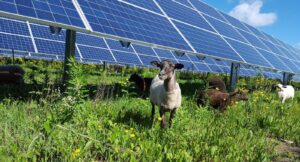Growing Interest in Agrivoltaics
A new study from the College of Agricultural, Consumer and Environmental Sciences (ACES) at the University of Illinois, presents possible solutions and highlights the current challenges of application of agrivoltaics, based on historical data of agricultural land use and current zoning and taxation laws.
“Even if states are promoting policies supportive of the nexus of agriculture and renewable energy, there will often be local pushback,” Guarino says. “Especially in rural areas, there can be a lot of opposition to bringing in new technology on agricultural land, which is highly valued. For the farmers working that land, it’s usually a generational thing, so they are emotionally invested as well. That kind of social tension evolves into legal challenges for agrivoltaics.”
Grazing presents yet another way to lower the costs of maintaining the solar field, instead of hiring a mowing company, making the sheep do all the work. Moreover, the conversion factor of agricultural land to renewable energy field is more socially accepted, since the land doesn’t loose its “fertile” properties.
The paper, “Emerging agrivoltaic regulatory systems: A review of solar grazing,” is published in the Chicago-Kent Journal of Environmental and Energy Law.

